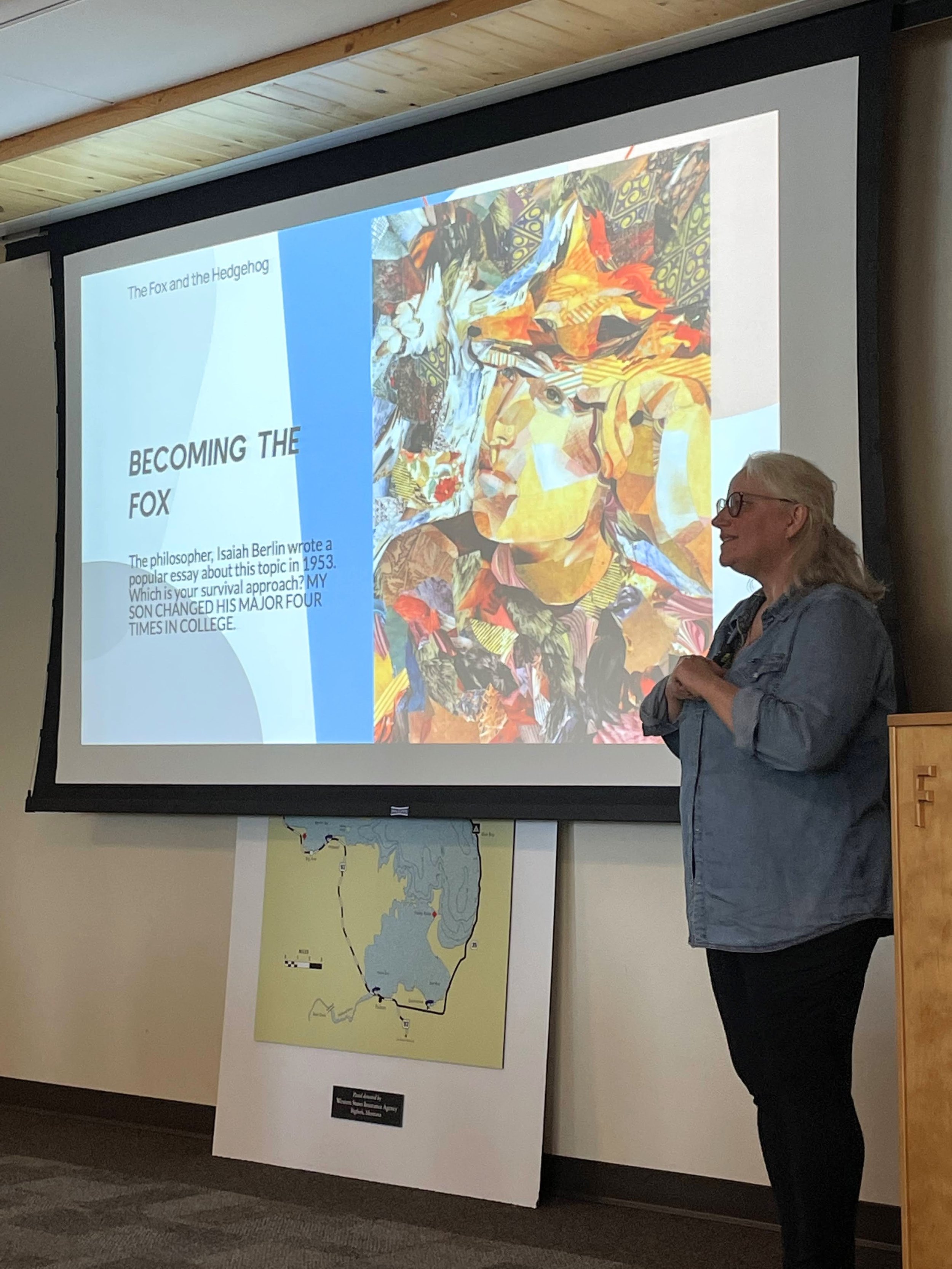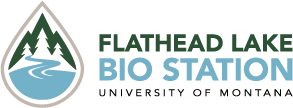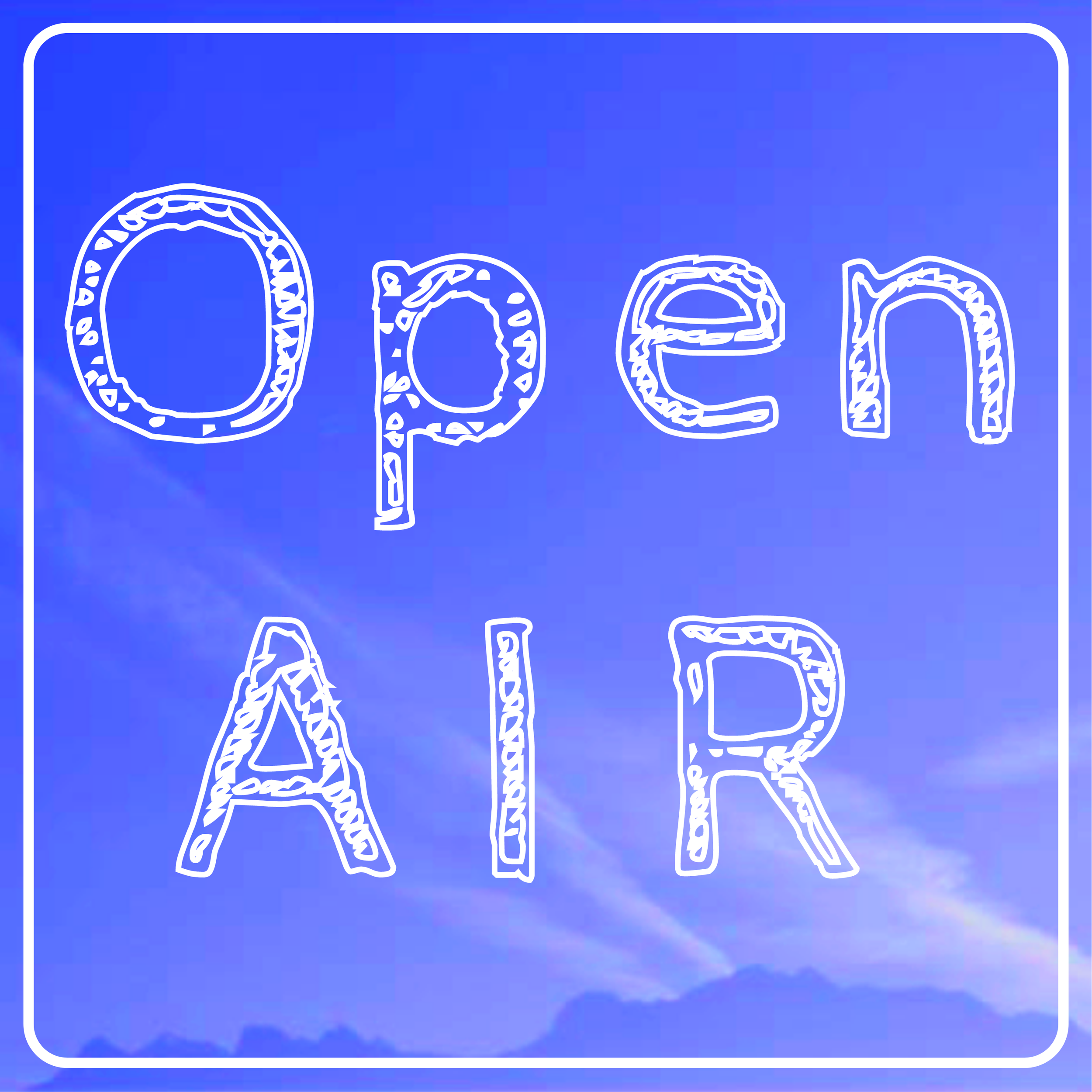Jennifer Ogden: SENSORY
“My “paper brushstrokes” as I call them, amalgamate on the page in a sensory experience.”
2022 Artist-in-Residence at Flathead Lake Biological Station
Field Station Sunset, 24”x18”, mixed media, Jennifer Ogden, 2022
How was your experience as an Open AIR Artist-in-Residence?
The Open AIR experience was an instructive privilege. There were new things to learn about Flathead Lake and her surrounding watershed. I met dedicated scientists and staffers at the Flathead Lake Biological Research Station (FLBS) and some dynamic students and interns there for a variety of reasons, from storytelling to lab work. Some gathered data out on the lake or went afield to sample tributaries, snow patches, or floodplains. Some long-term data was collected in the shrubbery right there on-site regarding Dome spider reproduction, or from weather stations on the peninsula. Americorps volunteers were called upon to mitigate non-native snapping turtles found on the wrong side of the Continental Divide and artists visited regularly for plein air painting sessions, but I was only able to join Sandra Marker’s group once. People reached out to me when they thought something might be of interest, and I learned that some of the staff had long-standing connections to this particular site. It's understandable, for the field station at Yellow Bay has its own magic. There is a constant sound of waves lapping the stoney beach, an abundance of native plants, the occasional shrill merlin call, industrious ground squirrels, and sometimes word around the camp of a skunk or bear. I finished each day rewarded by heavenly pink sunsets reflected on the large stretch of lake to the west where I would set my chair in the water and draw the vista, trying to understand wave patterns and the way the light reflected over distant swathes of water. When night finally settled in, the stars seemed incredibly close, hovering just above the tops of the Douglas and Grand fir, and Ponderosa pines which stood sentinel around my cabin. I felt quite fortunate.
Jennifer presenting her art process at the Flathead Lake Bio Station
What was your research process during this time?
Some of the FLBS scientists and interns spent real time with me in order to articulate their work. I learned a lot through conversations and felt privileged to hop onto the deck of the Jesse B. which is the primary research vessel named for a generous benefactor. The scientists would do intermittent monitoring and contribute new information to one of the oldest scientific databases about a freshwater lake in the country. (The field station was established in 1899). I got to assist as they measured and collected various things about the water body. In some instances I was subsequently able to look at such data samples under a powerful microscope and have them aptly explained. I looked into the subjects we covered online and I would often google things in real time during conversations so I could ask better questions. I relied on well-written FLBS literature which was prepared for visitors and attended a lecture by a visiting scientist from Japan who studies fish and water quality, as well as group presentations by Alpine Ecology students who had camped out in Glacier National Park. There were wonderful exit presentations by college interns whose projects ranged from modeling statistics on climate change for NASA, to environmental law, the nature of pink snow algae, artificial beaver dams potentially affecting wetland habitat, and making a photo ark of the myriad of phytoplankton seen over the past three decades at Flathead Lake, to name a favorite few. (I also gave a presentation in the Elrod Lecture Hall the first week I was there and I was able to add my collage print of the pink snow algae tech crew to the wall just after leaving). I spent a day at the Standing Arrow Powwow in Elmo under the Science Education Outreach tent helping with their Plankton Race activity which was a great lesson on the needs and structure of phytoplankton. I also spent time at the log cabin museum leafing through newspaper clippings, chap books and sketchbooks. As I mentioned before, the field station has a long history. Scientific illustration was one of the academic skills emphasized at one time. It was like sleuthing around in an old attic.
Watermelon Snow Tech Crew, 18”x24”, mixed media, Jennifer Ogden, 2022
What are you up to now (post Open AIR)?
While taking a little break from my K-12 Art position this year, I still attend events for teachers, such as the recent Montana History Conference in Red Lodge. I am leading some after-school classes at the Missoula Art Museum and at CM Russell Elementary in Missoula, and also doing lessons for a project called “Clay and Motion” at Heartism, a community center in Corvallis for autistic students. I get to collaborate on this with Heather Adams who is a contemporary dance teacher and our program is offered through an Artists in Schools and Communities grant. (Each group of students is delightful for different reasons). I made several bird sculptures for 4 Ravens gallery where I sell my paper mache pieces, and have some gallery exhibits coming up in Hamilton and Missoula where I will be showing new collage work. This is challenging as it takes so long to do the work I do. My husband and I hope to travel to Berlin in the spring so I am trying to be frugal. When I am not teaching, my job is to work on mixed media pieces. I am settling into a new routine which is differently purposeful.
Snowmelt Suite I, 12”x12”, up-cycle paper and cold wax, Jennifer Ogden, 2022
What keeps you returning to this subject, body of work?
I am still majorly mulling over my FLBS experience and have a few pathways mapped out. I have been working on a “Snow Melt Suite” in collage with cold wax, and I have a handful of larger mixed media pieces responding to the Open AIR/FLBS field work experience. One challenging piece of that series features a stoney beach on the Flathead River floodplain referred to as the “jar of marbles” by Tom Bansack, the Associate Director at FLBS. The differently colored stones each tell a story of their origin. His "marbles” analogy resonates as I piece together the image which makes me a bit cross-eyed because my paper brushstrokes are very tiny, but as it turns out I am getting the effect I wanted, which is the sensory feeling you get walking next to the river and admiring the wet stones. It puts you very much in the moment. I am also thinking about a phytoplankton series, which would be realistic and yet wildly abstract, and another about micro and macro plastics in the watershed, which is a troubling thing currently being monitored in the lake. I tried laser printing some of my lab photographs on metal, wood and linoleum blocks while visiting the maker space at Missoula Public Library last summer. I still want to see what can be done with my plates and blocks.
Oh Snap! The Invasive Harvest, 11”x14”, mixed media, Jennifer Ogden, 2022
When did you first begin working with this medium, media?
I always liked puzzles as a kid. It was a side effect of being visual, as opposed to musical or athletic. I come from a large family where we each had predilections. We had a relatively free range existence during our early years growing up near the Archie Bray Foundation in Helena, Montana. For a while we rented a brick farmhouse at the Green Meadows Golf Course so our “backyard” was a giant grassy expanse and our “front yard” was Spring Meadow Lake. My world was a vivid, moving kaleidoscope of sensory impressions inspired by the outdoors; fragrant lilac hedges, kid-sized thickets, sheltering trees, rural fields, stone walls, and shy crawdads effectively evading capture. Every lucid impression had a color or texture, adding to a dreamy patchwork convening edge-to-edge in my illuminated memory. That is the origin of how I understand and recall sensory experience and I recognize this vivid sensibility in my mixed media work. Mixed media is something I was quite drawn to in college which came about naturally while studying painting and photography. I had a great interest in collage, and even did assemblages which were little shadow box/cupboard wall pieces, but I mostly identified as a painter and did color drawing. Over time, however, I ended up teaching and then parenting, and sort of got away from things until about 15 years ago when all I wanted to do was piece together up-cycled paper onto a substrate as my preferred medium.
Jennifer print making with children while at the Flathead Lake Bio Station
Can you talk about the difference between being a maker/director of your own work and being a viewer?
From what I have experienced, people see all kinds of things in my work, and even though my ideas are fairly clear to me from the start, I rarely contradict other people’s impressions. I think they are responding to juxtapositions which can sometimes be unconventional pairings. My “paper brushstrokes” as I call them, amalgamate on the page in a sensory experience. If you consider the collage work of Surrealists and Dadaists they are pointing to an underlying experience of the subconscious. Certain combinations elicit feelings of recognition and perhaps disambiguation of meaning. I hope, as in Dadaism, people see freedom in sometimes irrational paper pairings. Oh Snap! The Invasive Harvest is a piece about a session I observed at FLBS where the snapping turtle mitigation team was removing the turtles’ carcasses from their shells on the tailgate of a truck. Snapping turtles are such fierce and profoundly prehistoric looking creatures. I mostly used magazine paper from cooking publications, selecting for certain colors and textures analogous to the armored but fleshy green and pink skin of the turtles. I cut apart images of silver fork tines and used them to depict claws. Although my “brushstrokes” came from beautifully photographed food, my picture is still a lavish but lurid scene. At our Open AIR pop up show at Gallery 709 I noticed it elicited feelings of unease where people could actually pinpoint areas which made them anxious. I have a plan to make a companion turtle piece for balance, but I need to gather a bit of strength before tackling that. Like some viewers, I experience disquiet with this topic despite being drawn into telling the story of a pond's apex predator.
Jennifer on the beach of Flathead lake
Follow her on Instagram @jenniferogden3031 or visit Jennifer’s website www.yellowkitchenstudio.net









